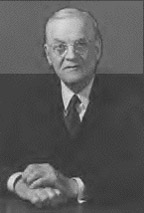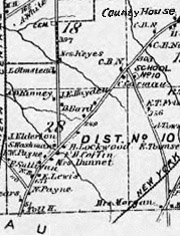|
-- the Relationship between Auburn and the Prison©
The site selected was the location of the prison farm which had been established in 1917. Twenty-five prisoners were housed there year round to take care of the cow herd, horses, pigs, and chickens. Extra work crews were sent out on a daily basis during the planting and harvesting season. The farm furnished two thirds of the fresh milk used in the institution each day. Fresh produce was provided during the summer and fall months. Other foodstuffs were obtained through contracts with local merchants and farmers. On September 18, 1931, the State purchased property at 67 South Street in Auburn from the Allen Dulles estate. It has since served as the residence for the wardens of the prison. Prior to the 1929 riots, the warden had lived on the prison grounds in an apartment in the Administration building.
A plan to modernize the facility had been proposed by the Legislature in 1927. A special bond issue of $10,000 had been made to study the project. Although pressure was applied by certain groups in Auburn to alter the plan, legislators decided that relocating the prison would be too expensive. A decision was made to reconstruct and enlarge the institution on the existing site. The second outbreak had occurred less than two months after the stock market crash of October 29th. The city of Auburn was hard hit when the Great Depression began following the crash. Business orders came to a standstill. Local manufacturing firms soon laid off workers, many of whom were unable to find jobs anywhere. RECONSTRUCTION Fortunately for Auburn, immediately following the crash the Legislature funded a major remodeling of the prison on State Street. Reconstruction of the physical plant began in earnest with the removal of the old cellblocks, administration building, kitchen, mess halls, and auditorium. Local mechanics were kept busy for years on construction work at the prison. New cell blocks were built with stone walls but steel cells. The size of the cells was increased to 61 wide, 8' long and 8' high. Modern plumbing was included. Essentially the same type of construction with interior cells and five tier high galleries was followed inside cellblocks. Three sides of each cell are solid steel. Barred cell doors are controlled by an officer operating a lock box control located at the end of each gallery. On September 18, 1931, the State purchased property at 67 South Street in Auburn from the Allen Dulles estate. It has since served as the residence for the wardens of the prison. Prior to the 1929 riots, the warden had lived on the prison grounds in an apartment in the Administration building. Under the leadership of wardens Joseph H. Brophy and John F. Foster rebuilding inside the prison continued over a 12-year period. The state, as part of its expansion plan, also purchased 16 acres of land west of the rear prison wall and a modern industrial complex was erected on the site. The new industrial plant housed the cabinet shops, license plate shops, cloth shops, bed shop, machine shop, and the broom and basket shop. Construction of a high cement wall was begun in 1930 around the area which had been secured for the enlargement of the institution. Various parts of the old wall were replaced by cement. Of the old stone wall, the only part remaining was along the front of the institution and part of the way along Wall Street. A welcome boost to the economy of Auburn occurred in 1936 when the work schedule of the guards was shortened to an eight-hour day. New positions were created in all institutions and many Auburnians were selected to attend guard school conducted at Wallkill Prison. After finishing school the new officers were assigned to posts in various institutions. Subsequently many transferred back to Auburn. Construction of the prison was halted during the World War II years. Due to an increase of inmates, cell block "E" completed in 1941 but not used, was finally opened in 1947. SET BACK IN CITY Following the depression, social and economic forces shaping America acted on Auburn as they did on many upstate cities. Wealth and talent were being concentrated in major urban areas; cities like Auburn experienced a gradual waning away. For Auburn this waning culminated in the closing of the International Harvester Plant in 1948. Over 2,000 people were left unemployed when International Harvester pulled out. Auburn has never overcome this loss. EXPANSION OF EDUCATION PROGRAM At the request of Warden Robert E. Murphy, in 1958 the old buildings which had once housed the women's prison were torn down to make room for a new educational building. The old buildings were 100 years old and had originally been erected to house criminally insane inmates received from Utica State Hospital. The facility closed in 1894 and inmates were transferred elsewhere. The buildings were then turned over to the state prison department for use as a prison for women. This prison remained in operation until 1933 when all remaining female inmates were transferred to Bedford Hills Prison for Women. The new school was ready for operation on Jan. 22,1961. It contains twelve vocational shops and fourteen academic classrooms, an assembly room and a music room. Today the Osborne School is fully accredited by the State Education Department and provides primary and secondary academic programs, high school equivalency and college programs in addition to specialized vocational training.
The school program was popular among inmates. John W. Rogers, Education Director, reported that "on March 6, 1969, 870 of the 1,559 men in the prison are enrolled in the school program, 342 in vocational courses. An average of 35 men annually graduate with regents high school diplomas and another 150 men yearly obtain high school equivalency diplomas. Both types are issued by the State Education Department and do not indicate that they were earned in prison. INMATE UNREST In the late 1960's the civil rights unrest in the nation had an effect on black inmates. Inspired by the success of demonstrations and protest marches outside, they demanded recognition inside. When their request to conduct a Black Solidarity Day observance was denied, they protested in their own way. An inmate disturbance of significance occurred on Nov. 4, 1970, when inmates refused to go to work or school classes at 8:30 a.m. They took over the main yard and soon had control of three cell blocks as well as the kitchen and mess hall areas. They also controlled the public address system in the main yard. They used the P.A. system to make speeches throughout the time they were in charge of the yard. No attempt to break out was made. It was a protest only. However, 43 employees were taken hostage and held during the day. Four employees were assaulted, none seriously. Several cells were damaged, the construction site of the new gym, library-chapel complex was vandalized, and part of the kitchen and storehouse area destroyed. The inmates gave up when told that state troopers were ready to retake the facility using force if necessary. Warden Harry Fritz agreed to study their grievances and not retaliate. The Auburn Prison was renamed Auburn Correctional Facility in 1970 to indicate a change in the philosophy of imprisonment in New York State. Inmates were not impressed by the name change. Several of the inmates involved in the protest over Black Solidarity Day at Auburn were transferred to Attica Prison during the following week. A year later they were active participants in the September 9-13 riot there. In 1971 a new building which houses the Media Center, gymnasium, exercise room, interview rooms, offices and chapel was completed in the main yard where it is readily accessible to all inmates. Library holdings in the Media Center include 8,000 volumes of fiction, nonfiction and reference materials. The gymnasium is especially popular in inclement weather. IMPACT OF COURT DECISIONS Following the Attica riot, there was an explosion in the number of court decisions affecting policies and programs in institutions. New law libraries were created in all state facilities to assist inmates in researching laws relating to their confinement, treatment, protection and health care needs. Courts have traditionally protected the rights of inmates to have access to the courts in order to have their grievances heard. Law is a complex business and inmates have a variety of ways they can ask a court to consider their grievances.
Many of the lawsuits brought by incarcerated persons are challenges to their conviction, however, rather than to their confinement. Many lawsuits are found to be frivolous and are dismissed. In keeping with the mandates of the courts, during the early 1970s efforts were made to develop more program activities for inmates on a state-wide basis. The influx of federal funds enabled officials to improve food service, expand counseling services, provide a new line of clothing issue, enlarge educational and vocational offerings, and involve volunteers from the community in various religious and social programs. The emphasis was on rehabilitation and individualized treatment. Contact visits are permitted in the new visiting room addition to the administration building which was opened in 1977. The old stone wall in front of the prison was removed and replaced with a low iron bar fence that same year. In the following year the stone wall on the west side of the original prison was also removed and replaced with a 12 foot high steel mesh fence. All remnants of the old dungeon were now gone. EMPLOYEE LABOR RELATIONS In the late 1970s the rehabilitative model of treatment came under strong attack. By 1979 public sentiments seemed to be flowing toward the notion that prison is basically for punishment and for society's protection, and that rehabilitative programs, while not to be abandoned, should play a secondary role in the formation of correctional policies and priorities. Many line members of the staff in the prison agreed. In 1979 employees conducted a walkout over contract provisions, salary considerations, and working conditions. The strike continued for sixteen days while negotiations were conducted in the Albany office by union representatives and officials of the Department of Correction. Meanwhile state troopers manned the perimeter wall at Auburn and local national guardsmen maintained order in the facility working under the direction of supervisors who remained on duty. Inmate cooperation during the job action was outstanding. They caused few incidents; none of any magnitude. |






